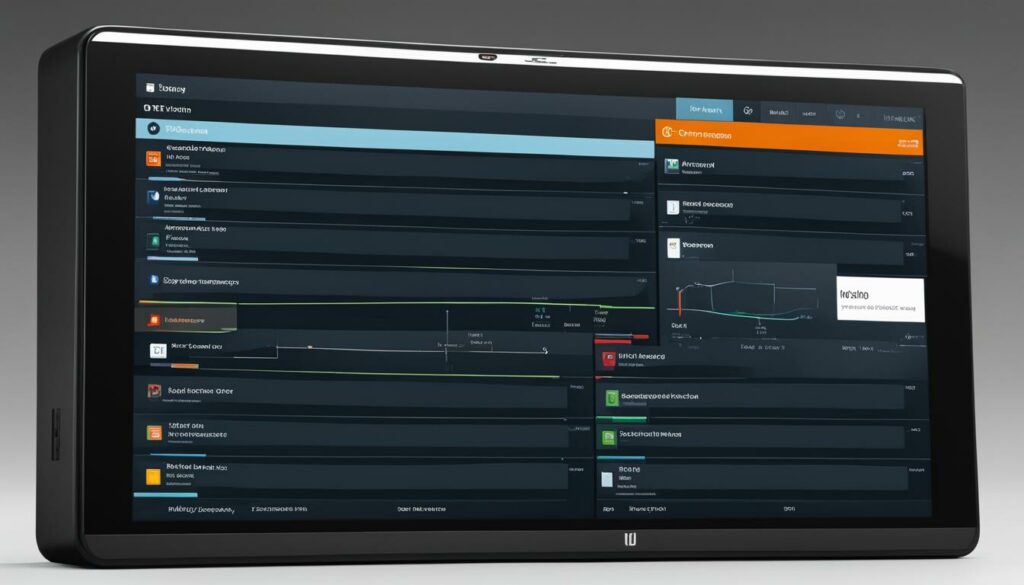Welcome to the world of web development powered by the WordPress REST API. As a WordPress developer, you are well aware of the endless possibilities this API brings to the table. From flexible data interaction to seamless platform integration, the WordPress REST API empowers you to create tailor-made solutions for your WordPress website.
Whether you are a seasoned WordPress developer or just getting started, understanding the power and potential of the WordPress REST API is crucial. With its RESTful architecture and standardized HTTP methods, the API opens up new avenues for content accessibility, user authentication, and cross-platform compatibility.
In this article, we will delve into the WordPress REST API and explore how you can leverage it to take your web development projects to the next level. We will cover everything from the basics of the API to its integration with other platforms, providing you with actionable insights and practical tips along the way.
Key Takeaways:
- The WordPress REST API allows developers to interact with WordPress data in a flexible and dynamic manner.
- It offers standardized HTTP methods for content manipulation, user authentication, and cross-platform compatibility.
- Using the WordPress REST API, developers can create tailored solutions based on project requirements.
- Benefits of leveraging the WordPress REST API include enhanced flexibility, efficient content management, and improved user experience.
- To get started with the WordPress REST API, you need to enable it on your WordPress site and explore the default endpoints.
Ready to unlock the full potential of the WordPress REST API? Let’s dive in!
What is the WordPress REST API?
The WordPress REST API is a powerful tool that allows developers to interact with WordPress data using standard HTTP methods. With its RESTful architecture, the API provides a flexible approach to content management, empowering developers to create, retrieve, update, and delete content in WordPress.
By following the principles of REST, the WordPress REST API enables seamless communication between clients and servers, making it easier to integrate with external platforms and applications. It supports various HTTP methods such as GET, POST, PUT, and DELETE, ensuring efficient data manipulation and management.
One of the key advantages of the WordPress REST API is its content accessibility. It provides endpoints for accessing different content types in WordPress, including posts, pages, categories, tags, and more. This allows developers to easily retrieve and display content in their applications or websites.
Furthermore, the API facilitates secure user authentication, allowing developers to implement user-based interactions and control access to protected resources. This authentication mechanism ensures that only authorized users can perform certain operations, enhancing the overall security of the system.
Another notable feature of the WordPress REST API is its cross-platform compatibility. It follows industry standards and leverages the power of HTTP, making it compatible with a wide range of platforms and technologies. This cross-platform compatibility enables developers to create seamless experiences across multiple devices and operating systems.
WordPress REST API in Action
“The WordPress REST API has transformed the way we develop websites and applications. Its straightforward integration capabilities allow us to leverage WordPress’s rich content management functionalities in our custom solutions, while ensuring cross-platform compatibility and user authentication.”
With the WordPress REST API, developers can unleash the full potential of WordPress in building tailored solutions for various use cases. Whether it’s a decoupled WordPress website, a mobile application, or an integration with another platform, the REST API provides the necessary tools to achieve these goals.
In the next section, we’ll explore how to leverage the WordPress REST API for web development and dive into its powerful HTTP methods for data manipulation, content management, and integration with other platforms.
How Does Leveraging WordPress REST API for Web Development Work?
Leveraging the power of the WordPress REST API is key to unlocking the full potential of web development. By mastering HTTP methods, developers can efficiently retrieve and manipulate data, ensuring a seamless user experience. Here’s how the WordPress REST API empowers developers with content manipulation, security implementation, platform integration, and tailored solutions.
Content Manipulation with WordPress REST API
With the WordPress REST API, developers have the ability to manipulate various content types effortlessly. Whether it’s creating, updating, or deleting content, the API provides flexible HTTP methods that simplify content management. This allows you to streamline workflows and optimize your website’s functionality.
Implementing Robust Security Measures
Security is paramount in web development, and the WordPress REST API offers robust security implementation. Developers can enforce authentication mechanisms to ensure that only authorized users have access to specific API endpoints. This helps protect sensitive data and prevent unauthorized actions, providing peace of mind for both developers and website visitors.
Seamless Platform Integration
The WordPress REST API enables seamless integration with external platforms, expanding the possibilities of your website. You can leverage the API to connect your WordPress site with other applications, services, or systems, creating an interconnected ecosystem. This integration opens up new opportunities for data sharing, cross-platform functionality, and enhanced user interaction.
Creating Tailored Solutions
Every web development project is unique, and the WordPress REST API allows developers to create tailored solutions based on specific project requirements. By utilizing the API’s flexible features, you can customize data retrieval, processing, and representation to match your project’s needs. This level of customization ensures that your website delivers a personalized and engaging user experience.
To exemplify the power of leveraging the WordPress REST API, check out the following table showcasing the different HTTP methods and their functionalities:
| HTTP Method | Functionality |
|---|---|
| GET | Retrieves data from the API |
| POST | Creates new data in the API |
| PUT | Updates existing data in the API |
| DELETE | Deletes data from the API |

By leveraging the WordPress REST API, web developers can harness the power of HTTP methods, manipulate content effectively, implement robust security measures, integrate with external platforms, and create tailored solutions. This combination of features empowers developers to build dynamic and secure websites that deliver exceptional user experiences.
Benefits of Leveraging WordPress REST API for Web Development
The WordPress REST API offers numerous benefits for web development projects. By utilizing this powerful API, you can enhance the flexibility of your website and streamline your content management processes, resulting in improved efficiency and productivity. Additionally, the WordPress REST API ensures cross-platform compatibility, allowing your website to seamlessly function on various devices and platforms. This not only expands your reach but also enhances the overall user experience, leading to higher customer satisfaction.
Let’s take a closer look at the key benefits of leveraging the WordPress REST API:
Enhanced Flexibility
With the WordPress REST API, you have the ability to interact with your website’s data in a versatile and dynamic manner. Whether you need to retrieve, create, update, or delete content, the API provides you with the necessary tools to perform these actions efficiently and effortlessly.
Efficient Content Management
The WordPress REST API streamlines content management by offering a standardized and structured approach. You can easily manipulate and organize your content, ensuring that it is displayed in a cohesive and user-friendly manner. This enables you to maintain a well-structured website and enables your team to work more efficiently.
Cross-Platform Compatibility
The WordPress REST API enables your website to function seamlessly across different platforms and devices. Whether your audience is using a desktop computer, a tablet, or a mobile phone, they can access and interact with your content without any issues. This ensures a consistent user experience, regardless of the device they are using.
Improved User Experience
The ultimate goal of any website is to provide a positive and engaging experience for its users. The WordPress REST API empowers you to create interactive and dynamic features that enhance the overall user experience. Whether it’s an interactive form, real-time updates, or personalized content, the API allows you to deliver a more engaging and tailored experience to your audience.
By leveraging the WordPress REST API, you can unlock the full potential of your website, offering enhanced flexibility, efficient content management, cross-platform compatibility, and an improved user experience.
We recommend WordPress Hosting from BoostedHost for optimal performance. Sign up now through this link: www.boostedhost.com/wordpress-hosting.

Getting Started With WordPress REST API
If you’re eager to leverage the power of the WordPress REST API for your web development projects, this section will guide you through the initial steps. By enabling the REST API on your WordPress site, exploring default endpoints, understanding custom post types, and setting up authentication, you’ll be well on your way to creating robust and secure API-based solutions.
Enabling the REST API on Your WordPress Site
Before you can start using the WordPress REST API, you need to ensure that it is enabled on your WordPress site. Thankfully, WordPress makes this process simple and straightforward.
To enable the REST API, follow these steps:
- Log in to your WordPress dashboard.
- Navigate to the “Settings” menu and click on “Permalinks”.
- Scroll down to the “Common Settings” section and select a permalink structure. This step is essential because the REST API relies on permalinks to generate clean and human-readable URLs for API endpoints.
- Click the “Save Changes” button to update your permalink settings.
Once you have enabled the REST API, you can move on to exploring the various default endpoints and understanding how they provide access to different types of content.
Exploring Default Endpoints
The default endpoints in the WordPress REST API are the building blocks for accessing and manipulating various types of content on your WordPress site. These endpoints follow a standardized structure, allowing you to retrieve and modify data using intuitive URLs.
Here are some of the primary default endpoints:
| Endpoint | Description |
|---|---|
| /wp/v2/posts | Retrieve and manage posts. |
| /wp/v2/pages | Retrieve and manage pages. |
| /wp/v2/categories | Retrieve and manage categories. |
| /wp/v2/tags | Retrieve and manage tags. |
| /wp/v2/users | Retrieve and manage users. |
These endpoints allow you to perform CRUD (Create, Read, Update, Delete) operations on different types of content. By sending HTTP requests to these endpoints, you can retrieve lists of items, create new items, update existing items, and delete items as needed.
Understanding Custom Post Types
In addition to the default endpoints, the WordPress REST API also provides support for custom post types. Custom post types allow developers to create and manage their own unique content structures on top of the default post and page types.
When exploring the REST API, it’s important to understand how custom post types are exposed and how you can interact with them. With the REST API, you can easily retrieve, create, update, and delete custom post types, just like you would with regular posts and pages.
Setting Up Authentication for Secure API Access
To ensure secure access to your WordPress REST API, it’s crucial to set up authentication. By implementing authentication, you can control who can access your API, protect sensitive data, and prevent unauthorized requests.
There are various authentication methods available for the WordPress REST API, including:
- OAuth 1.0a
- Application passwords
- JSON web tokens (JWT)
Choose the authentication method that best suits your project’s requirements and security needs. Once authentication is set up, you can enjoy the benefits of secure API access and confidently build powerful applications and integrations.
Now that you have a solid understanding of how to get started with the WordPress REST API, you’re ready to dive deeper into the possibilities it offers for your web development projects. In the next section, we’ll explore the various endpoints of the REST API in more detail, so you can fully leverage its capabilities.
Sign up for WordPress Hosting with BoostedHost to ensure optimal performance and unleash the true potential of the WordPress REST API. Transform your website into a dynamic and interactive platform that engages your users and delivers a superior experience. BoostedHost offers reliable hosting solutions tailored for WordPress, allowing you to focus on building remarkable websites. Visit www.boostedhost.com/wordpress-hosting to sign up now!
Understanding WordPress REST API Endpoints
WordPress REST API endpoints play a crucial role in interacting with different aspects of a WordPress site. These endpoints serve as gateways to access and manipulate data related to posts, pages, users, and more. By understanding how to utilize these endpoints effectively, developers can harness the power of the WordPress REST API to build dynamic and robust applications.
Resource identification is a key concept when working with WordPress REST API endpoints. Each endpoint corresponds to a specific resource or entity within the WordPress site. For example, the /wp/v2/posts endpoint represents the posts resource, while the /wp/v2/pages endpoint represents the pages resource.
CRUD operations, which stand for Create, Read, Update, and Delete, are the primary methods used to interact with these endpoints. Developers can create new posts, retrieve existing posts, update post content, and delete unwanted posts using the respective HTTP methods.
Parameter exploration allows developers to customize their requests and retrieve specific data from the API. Parameters can be used to filter posts based on categories, authors, tags, or any other desired criteria. This flexibility enables developers to fetch precisely the information they need.
The response format from the WordPress REST API is in JSON (JavaScript Object Notation), a widely-used data interchange format. JSON provides a structured and lightweight way to represent data, making it easy to process and consume by various programming languages and platforms.
Pagination handling is crucial when dealing with large datasets in API responses. WordPress REST API endpoints support pagination by dividing results into manageable chunks. Developers can specify the number of results per page and navigate through different pages of the response to access the desired data.
By mastering WordPress REST API endpoints, developers can build powerful applications that efficiently retrieve, manipulate, and present data from a WordPress site. Understanding how to identify resources, perform CRUD operations, explore parameters, handle responses, and navigate paginated results empowers developers to create dynamic and customized solutions for their projects.

Example: WordPress REST API Endpoints
| Endpoint | Description |
|---|---|
| /wp/v2/posts | Retrieves or manipulates posts on a WordPress site. |
| /wp/v2/pages | Retrieves or manipulates pages on a WordPress site. |
| /wp/v2/users | Retrieves or manipulates users on a WordPress site. |
| /wp/v2/categories | Retrieves or manipulates categories on a WordPress site. |
These are just a few examples of the available WordPress REST API endpoints. Each endpoint represents a specific resource that can be accessed and manipulated using CRUD operations, parameters, and pagination handling.
Leveraging the Power of HTTP Methods in WordPress REST API
The WordPress REST API provides developers with a range of standard HTTP methods that play a crucial role in retrieving, creating, updating, and deleting content. Understanding the power and functionality of these methods is essential for harnessing the full potential of the WordPress REST API.
Retrieving Data Using GET
The GET method allows you to retrieve data from the WordPress REST API. Whether you need to access a single post, a list of blog categories, or user information, the GET method provides a simple and efficient means of retrieving the desired data.
“GET method enables easy retrieval of data from the WordPress REST API.”
Creating Content Using POST
When it comes to content creation, the POST method is your go-to option. From publishing new blog posts to creating custom post types, the POST method empowers developers to add fresh and engaging content to their WordPress sites.
“POST method allows seamless content creation using the WordPress REST API.”
Updating Content Using PUT
The PUT method allows you to update existing content within your WordPress site. Whether it’s modifying a blog post, editing user information, or altering custom post types, the PUT method ensures that your content is always up to date and accurate.
“PUT method facilitates effortless content updating with the WordPress REST API.”
Deleting Content Using DELETE
When you need to remove content from your WordPress site, the DELETE method is your ally. Whether it’s deleting a post, removing a page, or eliminating user data, the DELETE method offers a straightforward approach to content deletion.
“DELETE method simplifies the process of content deletion with the WordPress REST API.”
By mastering these HTTP methods, developers can manipulate and manage content effectively using the WordPress REST API. It allows for seamless integration with external platforms, smooth data retrieval, efficient content creation, highly accurate content updating, and secure content deletion.
For a visual representation of the power of HTTP methods in the WordPress REST API, refer to the table below.
| HTTP Method | Description |
|---|---|
| GET | Retrieves data from the WordPress REST API |
| POST | Creates new content within the WordPress site |
| PUT | Updates existing content within the WordPress site |
| DELETE | Removes content from the WordPress site |
Being proficient in utilizing these HTTP methods empowers developers to fully leverage the capabilities of the WordPress REST API, enabling them to build dynamic and engaging websites.
Integrating WordPress with Other Platforms Using REST API
The WordPress REST API provides a powerful mechanism for seamless integration between WordPress and other platforms, enabling the creation of interconnected ecosystems. By leveraging the RESTful architecture and data sharing capabilities of the WordPress REST API, developers can enhance user interaction and deliver a cohesive experience across different devices and platforms.
With the WordPress REST API, you can establish a seamless connection between WordPress and other platforms, allowing for the exchange of data, content, and functionality. Whether you’re building a mobile app, integrating with a third-party service, or connecting your WordPress site to a custom software solution, the REST API offers the flexibility and versatility to meet your integration needs.
By integrating WordPress with other platforms using the REST API, you can take advantage of the diverse features and capabilities of both systems. For example, you can combine the content management capabilities of WordPress with the data analysis capabilities of a CRM platform, creating a comprehensive solution that streamlines workflows and enhances productivity.
Benefits of Integrating WordPress with Other Platforms
When you integrate WordPress with other platforms using the REST API, you unlock a range of benefits:
- Enhanced User Interaction: By leveraging the RESTful architecture and data sharing capabilities of the WordPress REST API, you can create seamless and engaging user experiences across different platforms.
- Expanded Functionality: Integrating WordPress with other platforms allows you to extend the capabilities of your website or application by leveraging the features and services of external systems.
- Streamlined Workflows: With interconnected ecosystems, you can automate processes, synchronize data, and eliminate redundant tasks, resulting in increased efficiency and productivity.
- Improved Data Insights: By combining data from multiple sources, you can gain deeper insights into user behavior, content performance, and other key metrics, enabling informed decision-making.
Overall, integrating WordPress with other platforms using the REST API provides a powerful way to enhance your digital presence, streamline workflows, and deliver a seamless user experience.
Platform Integration Examples
Here are a few examples of how you can integrate WordPress with other platforms using the REST API:
| Integration | Description |
|---|---|
| Salesforce Integration | Connect your WordPress site with Salesforce to synchronize customer data, track leads, and streamline sales processes. |
| Google Analytics Integration | Integrate Google Analytics with your WordPress site to track website traffic, user engagement, and conversion metrics in real-time. |
| MailChimp Integration | Sync your WordPress user database with MailChimp to automate email marketing campaigns and personalize communication with your audience. |
These are just a few examples of the many possibilities when it comes to integrating WordPress with other platforms using the REST API. The flexibility and data sharing capabilities of the API allow for endless customization and tailored solutions.
Sign up for WordPress Hosting from BoostedHost to ensure optimal performance and seamless integration with other platforms. BoostedHost offers reliable and secure hosting services tailored specifically for WordPress websites. Don’t miss out on the opportunities for platform integration and enhanced functionality.
Conclusion
The WordPress REST API is a game-changer for web development, offering seamless integration and unlocking enhanced functionality for your digital experiences. By leveraging this powerful API, businesses can optimize their websites, enhance system interconnectivity, and create unique value through APIs.
With the WordPress REST API, you can connect your WordPress website with a vast ecosystem of plugins and software, enabling endless possibilities for customized solutions. Whether you want to integrate with external platforms, develop decoupled WordPress installations, or build tailored functionality, this API provides the foundation for success.
By embracing API integration, you can unlock the true power of the WordPress REST API and take your online presence to new heights. Seamlessly connect your website with other platforms, streamline data sharing, and enhance user interaction. With the WordPress REST API, you have the tools to create a cohesive and consistent experience across different devices and platforms.
Ready to harness the power of the WordPress REST API? BoostedHost offers reliable and high-performance WordPress hosting, ensuring optimal API integration and smooth functionality. Sign up now through this link: www.boostedhost.com/wordpress-hosting and start elevating your web development projects today.
FAQ
Q: What is the WordPress REST API?
A: The WordPress REST API is a pivotal component in the world of web development, allowing developers to interact with WordPress data in a flexible and dynamic manner. It offers features such as flexible data interaction, standardized HTTP methods, content accessibility, user authentication, and cross-platform compatibility.
Q: How Does Leveraging WordPress REST API for Web Development Work?
A: Leveraging the WordPress REST API for web development involves mastering HTTP methods for consistent data retrieval and manipulation. It allows developers to manipulate various content types, implement robust security measures, integrate with external platforms, and create tailored solutions based on project requirements.
Q: What are the Benefits of Leveraging WordPress REST API for Web Development?
A: The WordPress REST API offers numerous benefits for web development projects. It enhances flexibility by providing versatile data interaction, streamlines content management for efficient workflows, enables cross-platform compatibility, and improves the overall user experience.
Q: How Do I Get Started With WordPress REST API?
A: To get started with the WordPress REST API, you need to ensure that it is enabled on your WordPress site. You can then explore the default endpoints, understand how custom post types are exposed, and set up authentication for secure API access.
Q: What are the WordPress REST API Endpoints?
A: WordPress REST API endpoints represent different aspects of a WordPress site, such as posts, pages, and users. Developers can interact with these endpoints using CRUD operations, customize requests with parameters, process API responses in JSON format, and navigate through paginated results.
Q: How Can I Leverage the Power of HTTP Methods in WordPress REST API?
A: The WordPress REST API utilizes standard HTTP methods, including GET, POST, PUT, and DELETE, to enable developers to retrieve, create, update, and delete content. Understanding the power of these methods is essential for effective utilization of the API.
Q: How Can I Integrate WordPress with Other Platforms Using REST API?
A: The WordPress REST API allows seamless communication between WordPress and other platforms, creating interconnected ecosystems. It supports RESTful architecture, enables data sharing, and enhances user interaction, providing a cohesive and consistent experience across different devices and platforms.
Q: What is the WordPress REST API’s Role in API Integration?
A: The WordPress REST API is a powerful tool for web development, offering seamless integration and enhanced functionality. By leveraging this API, businesses can optimize their digital experiences, enhance system interconnectivity, and create value through APIs. The REST API’s ability to connect with a vast ecosystem of plugins and software makes it a valuable asset for developers and marketers alike.












